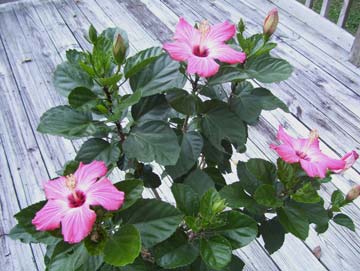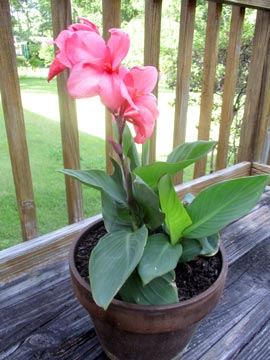The end of summer is punctuated by the first frost of fall. We all know it is coming and most of us get frosts sometime in October though some years in the south it can be as late as Thanksgiving. Tender plants need to be brought indoors before that first frost if you want to enjoy them again next year.
There are three types of plants that gardeners winter-over indoors:
 Tropical hibiscus
Tropical hibiscus
© Thinkstock
1. Tropical plants.These are defined as plants that really don’t like night temperatures below 50o f and are killed by the first frost. This includes Patio Hibiscus, Christmas Cacti and citrus trees. Most gardeners have these outside in containers all summer, so transition to indoors is quite easy.
 Rosemary brought inside
Rosemary brought inside
© Thinkstock
2. Plants that are not Winter Hardy. There will likely be plants in your landscape that are not winter hardy for your area. This depends on where you are but commonly includes rosemary (below zone 6); lemon verbena (below zone 7), scented geraniums (below zone 9).
 Pink Canna Lily on Deck
Pink Canna Lily on Deck
© Thinkstock
3. Bulbs and Tubers. These are the bulbs of plants that are not winter hardy in your area such as dahlia/canna bulbs (below zone 7). These plants can take some frost but the top growth is killed by temperatures below freezing.
For the first group your plants should be fertilized with a pre-move general fertilizer about a month before bringing inside. Move the plants into a light shade location for a few days. Continue to water consistently. Inspect the plants carefully for scale, whitefly and other insects and treat if needed before bringing the plant inside. After a few days of shade, bring the plants indoors to a sunny location, then finally to the winter location. Again, keep the moisture level consistent particularly if you have heating on which dries the air indoors. By November the plants are likely to be going dormant due to low light and should not be fertilized. The exception being the Christmas cacti which are now starting to put out blooms and a light fertilizer is fine.
For the second group, the plants are often in the ground and need to be dug before bringing indoors. Dig generously around the plants to get all the roots, then let excess soil drop off. The plants should be placed in a container that accommodates all the roots and watered lightly. Keep rosemary in a cool, bright location and water sparingly over winter – it should never dry out but excess water along with long nighttime hours tends to create fungal issues and kills the plant.
Lemon verbena, lemon grass and scented geraniums are all quite large at the end of the season. Trim these back to about 18-24” to make them acceptable indoor plant size. Like rosemary, dig the whole root and divide if necessary to make a plants small enough to bring indoors. Compost or dry the leaves that are discarded.
 Bulbs for storage
Bulbs for storage
© Kate Copsey
All plants that are being brought indoors should be potted up a week or so before bringing indoors and checked for insects. Transition in a similar way to group 1 but omit fertilizer as these plants are going to be dormant very soon. Keep in a cool area over winter to avoid the plants growing again.
The third group of plants are those bulbs and tubers that are damaged by freezing ground. Let the top growth of the plants die in the first hard frost, then dig the bulbs. Remove all dirt from the bulbs and layer them in large moisture-proof boxes filled with perlite. Put the box in a dark basement until spring arrives, checking occasionally for rotting bulbs which should be removed promptly.
by Kate Copsey